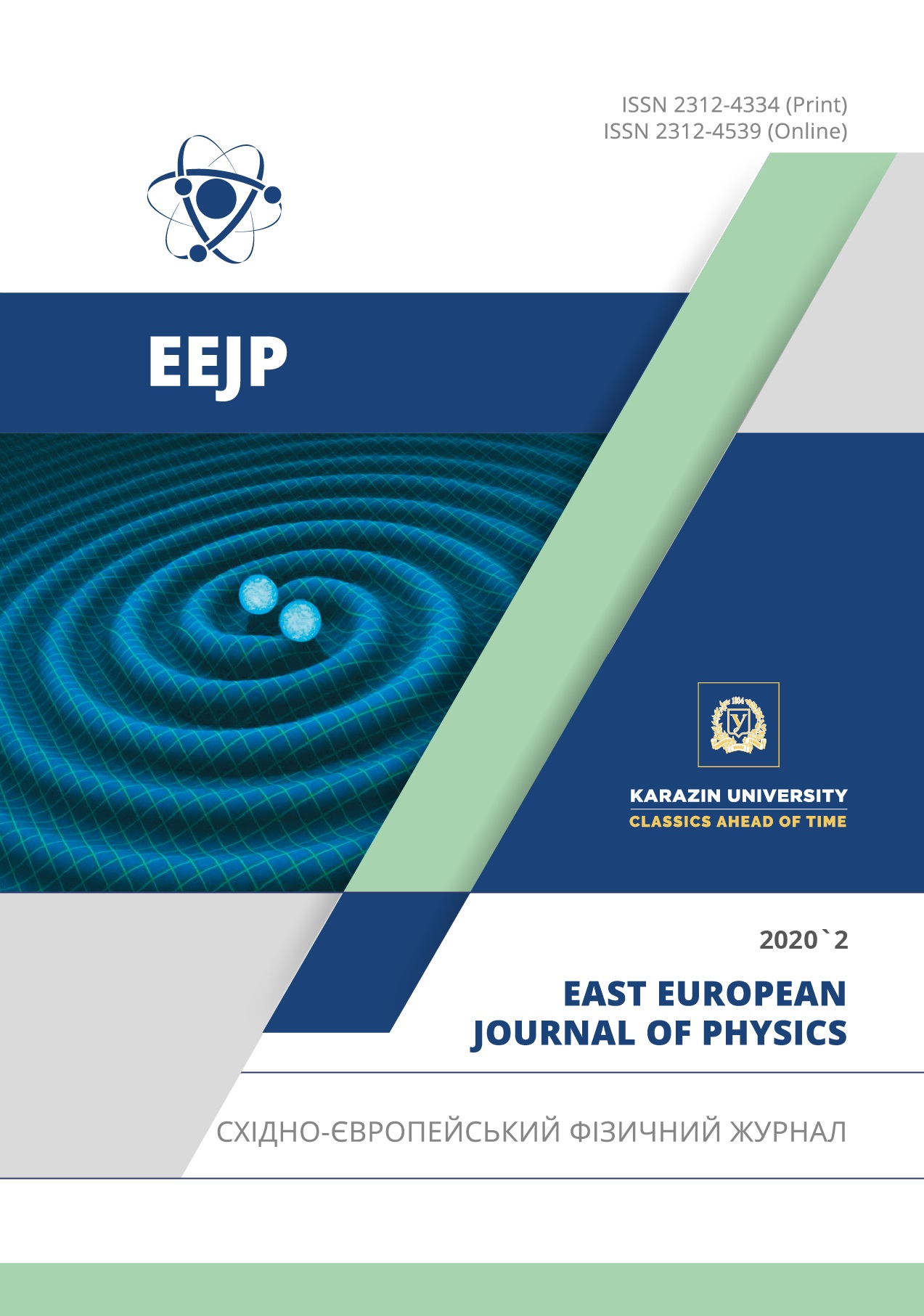Про періодичні зміни світності космічних джерел з активним середовищем
Анотація
Розглянуто наявність в гарячому джерелі випромінювання внутрішнього шару з активним середовищем, що знаходиться поблизу рівноваги і представлено квантовою дворівневою системою, населеністі верхнього і нижнього рівнів якої приблизно однакові. Показано, що при конвекції з більш глибоких гарячих шарів, яка підтримує інверсію населеністі активної системи, можлива генерація імпульсів індукованого випромінювання, інтенсивність яких порівнянна або перевершує інтенсивність фонового спонтанного випромінювання джерела. При достатній товщині поверхневих шарів за рахунок ефектів розсіювання в них, там цілком може сформуватися спектр випромінювання абсолютно чорного тіла. Генерація імпульсів поблизу виявленого раніше нового порога індукованого випромінювання здатна привести до періодичної зміни інтенсивності випромінювання джерела в цілому. Цей поріг визначається рівністю квадрату інверсії населеності повному числу станів. Розгляд генерації імпульсів індукованого випромінювання проводиться як на основі балансних рівнянь, так і за допомогою напівкласичного опису при невеликих значеннях інверсії населеності і при низьких рівнях інтенсивності електричного поля, коли частота Рабі менше ширини лінії. Опис процесу індукованого випромінювання зводиться до однопараметричної системі рівнянь. Періодичні рішення представлені замкнутими траєкторіями на фазової площині (відносна щільність квантів, відносна щільність інверсії населеністі). Подібний шар з активним середовищем в вигляді квантової дворівневої системи може існувати в зірках і швидше за все локалізован в області фотосфери. При наявності в атмосфері зірки значною конвекції можуть бути реалізовані умови для генерації імпульсів індукованого випромінювання. Виявляється, що можна побачити подібність отриманих рішень з відомими спостереженнями змін світності зірок-цефеїд (дельти Цефея і Полярної зірки).
Завантаження
Посилання
А. Einstein, Mitteilungen, D. Phys. Ges. Zürich 18, 47–62 (1916); Phys. Z. 18, 121-128 (1917); UFN 86 (3), 371–411 (1965), https://doi.org/10.3367/UFNr.0086.196507b.0371, in https://ufn.ru/ru/articles/1965/7/b/, (in Russian).
R. Ladenburg, Rev. Mod. Phys. 4, 243-260 (1933); UFN 14 (6), 721–741 (1934), https://doi.org/10.3367/UFNr.0014.193406b.0721, in https://ufn.ru/ru/articles/1934/6/b/, (in Russian)
L.D. Landau, and E.M. Livshits, Electrodynamics of continuous media. (Moscow, GIFLML, 1959), pp. 532, (in Russian).
V.L. Ginzburg, UFN, 140 (4), 687–698 (1983), (in Russian)
Ch.H. Townes, Science, 149 (3686), 831-841 (1965), https://doi.org/10.1126/science.149.3686.831; UFN. 88 (3), 461–483 (1966), (in Russian).
A.G. Zagorodny, and V.M. Kuklin, in: High-power pulsed electrophysics. International conference XIV Khariton’s topical scientific readings. Digest of technical papers (Sarov, 2013), pp. 38-43, (in Russian)
A.V. Kirichok, V.M. Kuklin, A.V. Mischin, A.V. Pryjmak, and A.G. Zagorodny, VANT. Ser.: Plasma Electronics and New Methods of Acceleration, 4 (77), 267-271 (2013).
S.B. Pickelner, Atmospheres of stars, (Physics of Space, 1986), http://www.astronet.ru/db/msg/1179555, (in Russian)
C.L. Statz, and G. DeMars, Quantum Electronics, (N.Y., Columbia Univ. Press, 1960), pp. 530.
A.V. Kirichok, V.M. Kuklin, and A.G. Zagorodny, VANT. Ser.: Plasma Electronics and New Methods of Acceleration, 4 (80), 9-11 (2015), https://arxiv.org/pdf/1610.04628v1.
P.S. Landa, Self-oscillations in distributed systems, (Moscow, Nauka, 1983), pp. 320, in Russian
A.S. Davydov, Quantum mechanics, (Fizmatgiz, Moscow, 1963), pp. 748, in Russian
L. Allen, J. Eberly, Optical resonance and two-level atoms. (New York, Wiley‐Interscience, 1975), pp. 222.
A.S. Rastorguev, Lectures on Galactic Astronomy, in http://www.astronet.ru/db/msg/1228262, in Russian
J. Kaler, Stars and stars of the week, (University of Illinois), in http://stars.astro.illinois.edu/sow/deltacep.html
J. Kaler, Stars and stars of the week, (University of Illinois), in http://stars.astro.illinois.edu/sow/polaris.html
N.N. Samus, and O.V. Durlevich, GCVS - General Catalog of Variable Stars, (Institute of Astronomy of Russian Academy of Sciences, Sternberg State Astronomical Institute of the Moscow State University), in: http://heasarc.gsfc.nasa.gov/W3Browse/all/gcvs.html.
Авторське право (c) 2020 В.В. Костенко, В.М. Куклін, Є.В. Поклонський

Цю роботу ліцензовано за Міжнародня ліцензія Creative Commons Attribution 4.0.
Автори, які публікуються у цьому журналі, погоджуються з наступними умовами:
- Автори залишають за собою право на авторство своєї роботи та передають журналу право першої публікації цієї роботи на умовах ліцензії Creative Commons Attribution License, котра дозволяє іншим особам вільно розповсюджувати опубліковану роботу з обов'язковим посиланням на авторів оригінальної роботи та першу публікацію роботи у цьому журналі.
- Автори мають право укладати самостійні додаткові угоди щодо неексклюзивного розповсюдження роботи у тому вигляді, в якому вона була опублікована цим журналом (наприклад, розміщувати роботу в електронному сховищі установи або публікувати у складі монографії), за умови збереження посилання на першу публікацію роботи у цьому журналі.
- Політика журналу дозволяє і заохочує розміщення авторами в мережі Інтернет (наприклад, у сховищах установ або на особистих веб-сайтах) рукопису роботи, як до подання цього рукопису до редакції, так і під час його редакційного опрацювання, оскільки це сприяє виникненню продуктивної наукової дискусії та позитивно позначається на оперативності та динаміці цитування опублікованої роботи (див. The Effect of Open Access).








